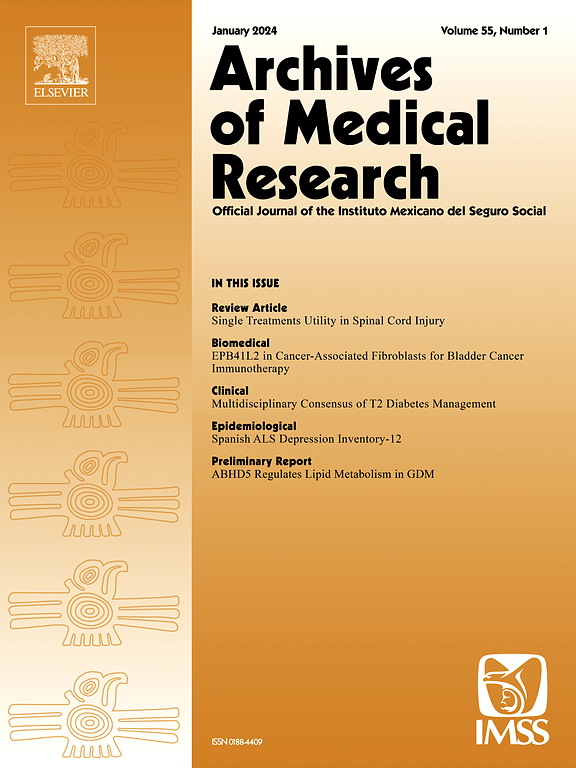Impact of IL-17a on Apoptosis and Mucinosis-Related Molecules in the Microenvironment of Colorectal Cancer
IF 3.4
3区 医学
Q1 MEDICINE, RESEARCH & EXPERIMENTAL
引用次数: 0
Abstract
Background/Aims
IL17-producing Th17 represent a distinct subset of T-cells. The link between IL-17a and the colorectal cancer (CRC) microenvironment has been widely accepted. However, the role of IL-17a in epithelial cell apoptosis, autophagy, mucinosis, ultrastructural changes, and their potential correlations with CRC remains unclear.
Materials and Methods
Out of 2890 patients with CRC, 200 were divided into four groups (stage I-IV) and 50 into non-CRC/healthy/control. We investigated the relationship between IL-17a, apoptosis, autophagy, and mucinosis in patients with stage I-IV CRC (in vitro/vivo). In addition to many (para)clinical assessments, IL-17a load in blood and the tumor microenvironment (TME) in patients with CRC were assessed. To examine these associations, the effect of IL-17a on CRC cells was evaluated using qPCR, Western blotting, ELISA, bioluminescence, flow cytometry, and immunohistochemistry (IHC), and ultrastructural changes in the colonic epithelia were assessed by scanning and transmission electron microscopy.
Results
IL-17a is overexpressed in stage I–IV in the TME and in stage III–IV in the blood of patients with CRC. IL-17a upregulated apoptosis (caspases, cytochrome c (CYC), higher Bax:Bcl2 ratio), autophagy (SIRT1 and LC3), and the cell cycle (TP53, APC-1) and downregulated B3GALNT2 and mucins and led to morphological and nuclear changes in CRC epithelia.
Conclusions
IL-17a is abundantly expressed in the CRC microenvironment, and IL-17a-IL-17aR interactions play a critical role in the control of apoptosis and mucinosis. The observed remarkable association of IL-17a and apoptosis in adenocarcinoma provides valuable insight into the clinical implications of Th17/IL-17 in CRC.

IL-17a对结直肠癌微环境中细胞凋亡及黏液病相关分子的影响
产生aimsil17的Th17代表了t细胞的一个不同的亚群。IL-17a与结直肠癌(CRC)微环境之间的联系已被广泛接受。然而,IL-17a在上皮细胞凋亡、自噬、粘液沉积、超微结构改变中的作用及其与结直肠癌的潜在相关性尚不清楚。材料与方法2890例结直肠癌患者中,200例分为4组(ⅰ-ⅳ期),50例分为非结直肠癌组/健康组/对照组。我们研究了I-IV期CRC患者IL-17a与细胞凋亡、自噬和黏液沉积的关系(体外/体内)。除了许多(para)临床评估外,还评估了CRC患者血液中IL-17a负荷和肿瘤微环境(TME)。为了检验这些关联,使用qPCR、Western blotting、ELISA、生物发光、流式细胞术和免疫组织化学(IHC)评估IL-17a对结直肠癌细胞的影响,并通过扫描和透射电镜评估结肠上皮的超微结构变化。结果sil -17a在I-IV期TME和III-IV期CRC患者血液中均有过表达。IL-17a上调凋亡(caspases、cytochrome c (CYC)、Bax:Bcl2比值升高)、自噬(SIRT1和LC3)和细胞周期(TP53、APC-1),下调B3GALNT2和粘蛋白,导致结直肠癌上皮细胞形态和细胞核改变。结论il -17a在结直肠癌微环境中大量表达,il -17a与il - 17ar的相互作用在控制结直肠癌细胞凋亡和粘液沉积中起关键作用。观察到的IL-17a与腺癌细胞凋亡的显著相关性为Th17/IL-17在结直肠癌中的临床意义提供了有价值的见解。
本文章由计算机程序翻译,如有差异,请以英文原文为准。
求助全文
约1分钟内获得全文
求助全文
来源期刊

Archives of Medical Research
医学-医学:研究与实验
CiteScore
12.50
自引率
0.00%
发文量
84
审稿时长
28 days
期刊介绍:
Archives of Medical Research serves as a platform for publishing original peer-reviewed medical research, aiming to bridge gaps created by medical specialization. The journal covers three main categories - biomedical, clinical, and epidemiological contributions, along with review articles and preliminary communications. With an international scope, it presents the study of diseases from diverse perspectives, offering the medical community original investigations ranging from molecular biology to clinical epidemiology in a single publication.
 求助内容:
求助内容: 应助结果提醒方式:
应助结果提醒方式:


